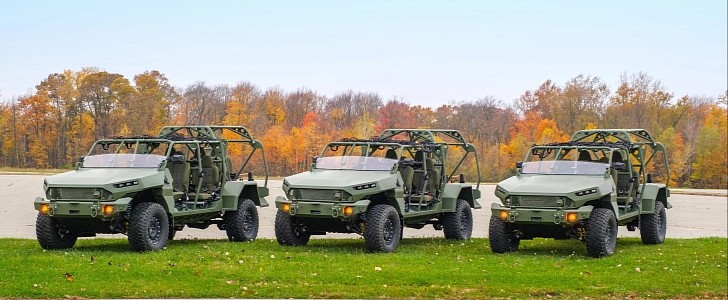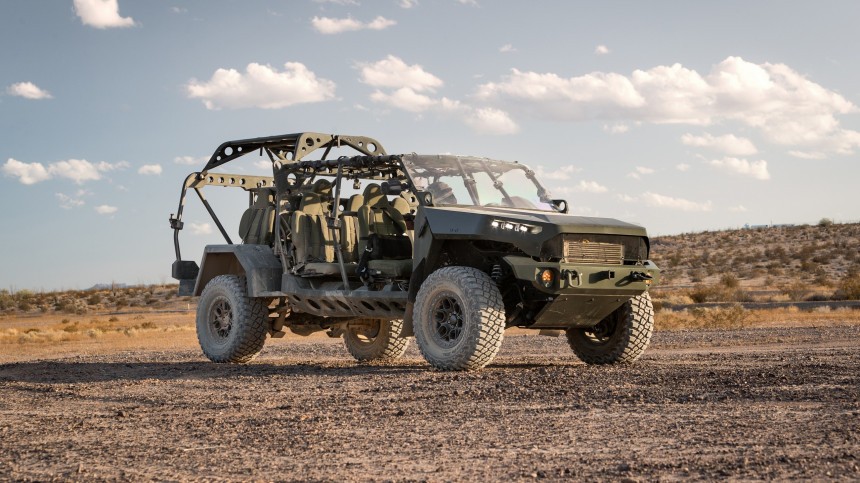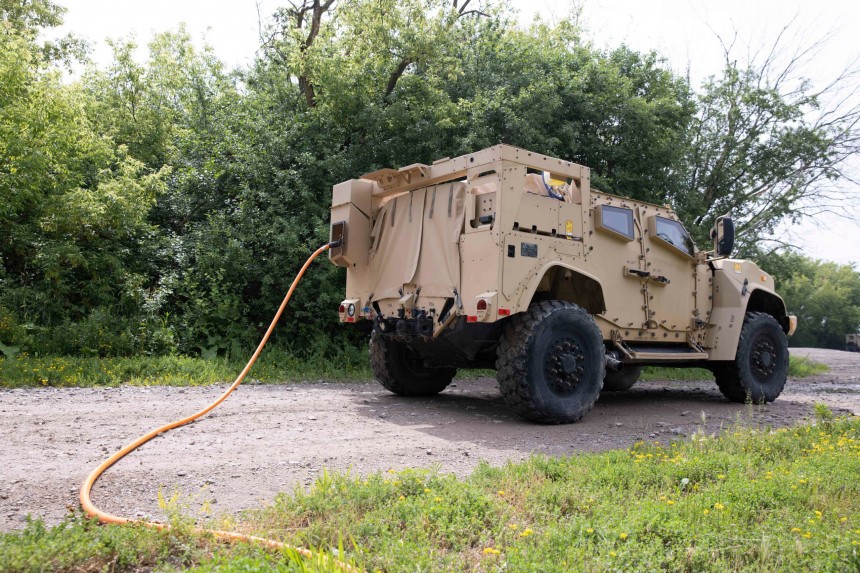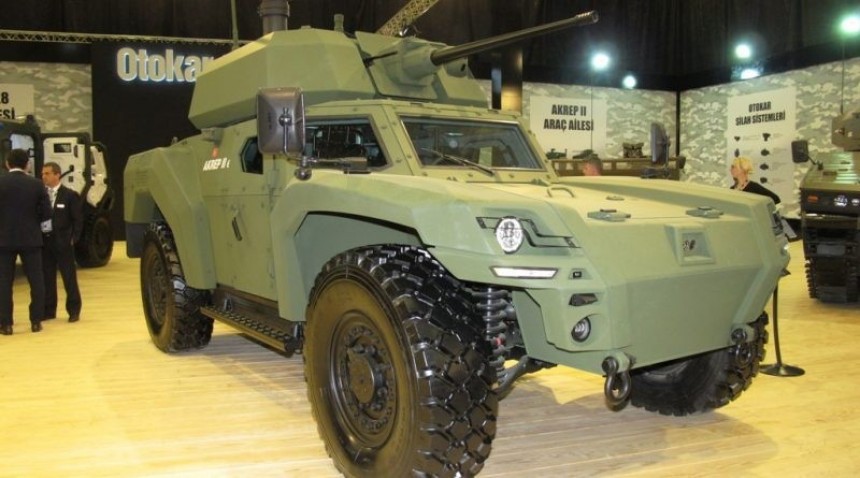A short time ago, we showed you why in all likelihood, militaries across the globe, but especially in the U.S., are going to be all but exempt from the EV revolution. But this isn't a hard and fast rule, as it turns out.
The U.S. Armed Forces, as well as others, are at least passively interested in EV technology as an emergency backup to its vast fleet of gasoline and diesel vehicles. A handful of military contractors have spent legitimate time, money, and resources developing a series of all-electric vehicles with a wide range of powerplants. Whether battery-powered, chemical fuel cells, or solar, there's at least an existent possibility of seeing one of these vehicles out on patrol sometime in the future.
Just for a bit of fun, let's take a little dive into the newly emerging world of electric and electric/hybrid military vehicles. Firstly, let's start with GM Defense. The military/police branch of General Motors that does so much more than installing bulletproof glass in HD Suburbans we aren't allowed to buy. It turns out GM is putting their civilian-developed EV technology into a bold new military truck prototype.
Dubbed the Infantry Squad Vehicle (ISV), this Chevy Colorado ZR2 based truck was originally meant to carry a 2.8-liter turbodiesel engine under its hood. At least in its latest EV prototype form, this diesel powerplant is replaced with GMs own EV crate motor system. The very same that GM plans to sell to the aftermarket car modding market.
Jetting 200 horsepower and 266 foot-pounds of torque from its battery EV arrangement, it's good for a range somewhere in the 70 to the 150-mile territory (112.7 to 241.4 km). Sure, none of that sounds all that impressive. But remember, people thought the day when civilian EVs could crack the 300 miles of range barrier was just a pipe dream only a decade ago. So who knows just how much these numbers may improve.
As we all know, the enemy of the EV is weight. It spoils the handling, makes vehicles less efficient, and worst of all, makes them slower. With this in mind, the doorless roll cage and outer frame construction on the electric ISV can only be positive attributes. Especially on battlefields where supercharging stations are either non-existent or turned into piles of rubble.
Moving away from "Government Motors," we bring your attention to Oshkosh Defense of Wisconson. A company that's been contracted to build utility trucks and other vehicles for the U.S. Armed Forces for almost 50 years.
Now, there are plans to add some extra electric boost to an Oshkosh vehicle slated to replace the iconic Humvee. The Joint Light Tactical Vehicle (JLTV) is already a menacing and capable utility 4x4.
But the addition of a silent battery and electric motor to the JLTV could be an asset that makes traditionally noisy military trucks operate in near silence. Dubbed the eJLTV, this hybrid prototype is capable of running on silent battery mode for up to 30 minutes. Enough time to sneak behind enemy lines in pitch darkness, raise all kinds of hell, extract trapped soldiers, and then drive back to base.
The eJLTV's diesel motor charges the battery cells consistently while in use. It's believed the regenerative charging system can fully charge the vehicle's batteries in as little as half an hour. Thus eliminating range anxiety that's highly annoying to us civilians but could mean the difference between survival on the battlefield.
Rounding things off, we have a vehicle not from the U.S. but from Turkey. The Otokar Akrep II. Like the Oshkosh design mentioned above. This armored car, first unveiled in 2019, was a standard petroleum-powered 4x4 first and a radical diesel-electric hybrid and battery EV test platform second.
Similar in size to a Humvee or the aforementioned Oshkosh platform, the Akrep is due to serve its native Turkish armed forces and possibly the militaries of foreign governments who express interest in the technology.
Otokar has expressed that the Akrep IIe has a full EV range of as much as 200 kilometers (124 miles) via twin electric motors jetting 240 horsepower each. Again, that may sound pathetic to people with civilian sensibilities.
But when you're in the thick of a battlefield besieged by rifle fire, artillery, and bomb blasts, being able to switch into silent full-EV mode could be nothing short of the difference between making it and not making it back to base.
To say that the immediate future of military hardware will undergo the same renaissance it did in the civilian sector would not be accurate. But with these three vehicles in mind, it would also be wrong to say global militaries are completely disinterested in EV tech. Eventually, when the world runs out of oil, we'll be thankful that they at least gave it a try. Check back for more from EV month right here on autoevolution.
Just for a bit of fun, let's take a little dive into the newly emerging world of electric and electric/hybrid military vehicles. Firstly, let's start with GM Defense. The military/police branch of General Motors that does so much more than installing bulletproof glass in HD Suburbans we aren't allowed to buy. It turns out GM is putting their civilian-developed EV technology into a bold new military truck prototype.
Dubbed the Infantry Squad Vehicle (ISV), this Chevy Colorado ZR2 based truck was originally meant to carry a 2.8-liter turbodiesel engine under its hood. At least in its latest EV prototype form, this diesel powerplant is replaced with GMs own EV crate motor system. The very same that GM plans to sell to the aftermarket car modding market.
Jetting 200 horsepower and 266 foot-pounds of torque from its battery EV arrangement, it's good for a range somewhere in the 70 to the 150-mile territory (112.7 to 241.4 km). Sure, none of that sounds all that impressive. But remember, people thought the day when civilian EVs could crack the 300 miles of range barrier was just a pipe dream only a decade ago. So who knows just how much these numbers may improve.
Moving away from "Government Motors," we bring your attention to Oshkosh Defense of Wisconson. A company that's been contracted to build utility trucks and other vehicles for the U.S. Armed Forces for almost 50 years.
Now, there are plans to add some extra electric boost to an Oshkosh vehicle slated to replace the iconic Humvee. The Joint Light Tactical Vehicle (JLTV) is already a menacing and capable utility 4x4.
But the addition of a silent battery and electric motor to the JLTV could be an asset that makes traditionally noisy military trucks operate in near silence. Dubbed the eJLTV, this hybrid prototype is capable of running on silent battery mode for up to 30 minutes. Enough time to sneak behind enemy lines in pitch darkness, raise all kinds of hell, extract trapped soldiers, and then drive back to base.
Rounding things off, we have a vehicle not from the U.S. but from Turkey. The Otokar Akrep II. Like the Oshkosh design mentioned above. This armored car, first unveiled in 2019, was a standard petroleum-powered 4x4 first and a radical diesel-electric hybrid and battery EV test platform second.
Similar in size to a Humvee or the aforementioned Oshkosh platform, the Akrep is due to serve its native Turkish armed forces and possibly the militaries of foreign governments who express interest in the technology.
Otokar has expressed that the Akrep IIe has a full EV range of as much as 200 kilometers (124 miles) via twin electric motors jetting 240 horsepower each. Again, that may sound pathetic to people with civilian sensibilities.
But when you're in the thick of a battlefield besieged by rifle fire, artillery, and bomb blasts, being able to switch into silent full-EV mode could be nothing short of the difference between making it and not making it back to base.
To say that the immediate future of military hardware will undergo the same renaissance it did in the civilian sector would not be accurate. But with these three vehicles in mind, it would also be wrong to say global militaries are completely disinterested in EV tech. Eventually, when the world runs out of oil, we'll be thankful that they at least gave it a try. Check back for more from EV month right here on autoevolution.










